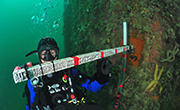Benthos
Type of resources
Available actions
Topics
Keywords
Contact for the resource
Provided by
Years
Formats
Representation types
Update frequencies
status
Scale
Resolution
-
The use of an ecological niche model has made it possible to characterize, on the one hand, the effects of climate change on the native species of the Bay of Biscay, such as displacements of favorable habitats towards higher latitudes, or, in a to a lesser extent, a decrease in the area of favorable habitat for native species. On the other hand, the potential displacement of the favorable habitat of some subtropical species (currently present along the Moroccan coast) in the Bay of Biscay could be expected. They would then become non-indigenous species (NIS)
-
This deliverable consists of two parts, first a legal guide to environmental assessment for floating wind farm projects, then in a second part, a study on the legal framework for the spatial planning of floating wind farms: The place of environmental assessment
-
A spatialized EwE model was built covering the continental shelf of the Bay of Biscay. From this base, six ECOPATH models were built: a current model serving as a reference, a model only including the effect of climate change on native species, and four models also simulating the arrival of NIS under different hypotheses of biomass. These models include 44 native trophic groups ranging from primary production to top predators, including 13 monospecific groups of commercial interest, and two non-living groups. In addition, 8 non-indigenous trophic groups and 11 fishing fleets have been integrated in order to model the main professions operating today in the Bay of Biscay
-
The portal presents the objectives of the APPEAL project for large communication
-
A vidéo titled "Food Webs and the socio-ecosystem approach: towards a better understanding of environmental intégration of offshore renewable energies"
-
The use of an ecological niche model has made it possible to characterize on the one hand the effects of climate change on the native species of the Gulf of Lio, such as displacements of favorable habitats or the reduction of the surface of the habitat. favor of native species. On the other hand, the potential displacement of the favorable habitat of some subtropical species in the Gulf of Lion could be expected. They would then become non-indigenous species (NIS)
-
This work seeks to understand to what extent the future wind farms that will be established in the Channel and the Atlantic can complement the existing network of MPAs in terms of surface gain on the one hand and coverage of the three facets of biodiversity (taxonomic, functional, phylogenetic) on the other hand. In a second step, a draft optimization of the network of wind farms in the Bay of Biscay and in the English Channel was carried out in order to identify the locations optimizing the conservation of taxonomic diversity
-
Videos of the final restitution meeting of the results of the APPEAL project which took place face-to-face in Lorient on March 8, 2022
-
This deliverable refers to the socio-ecosystem model that has been developed
-

This study provides the first maps of the Benthic Invertebrate Biophonies (BIB) at ecologically relevant scales and shows that they can be used to identify, quantify, follow and track benthic activity hot-spots. In combination with biological and ecological information, passive acoustic monitoring using such maps can be a powerful complementary tool for ecological studies, such as the quantification of grazing activity or the evaluation of the efficiency of marine ecologic restoration programs.
 Catalogue PIGMA
Catalogue PIGMA